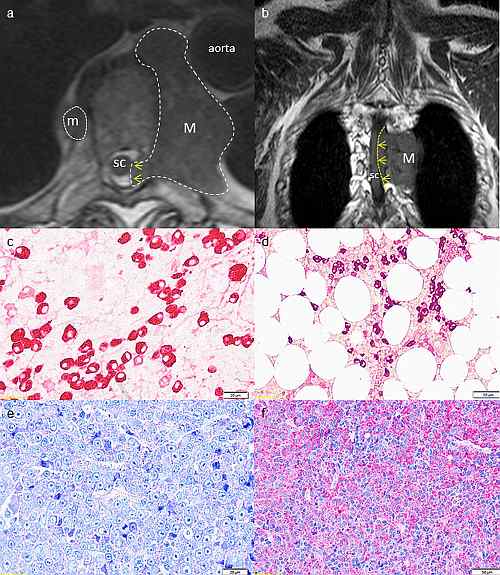
Contributions
Type: Publication Only
Background
IgD Multiple Myeloma (MM) is one of the rarest type of MM, representing almost 2% of all myeloma cases. It has been reported a poorer outcome of this variant when compared with other subtypes, with an aggressive course, high incidence of bone complications, extramedullary disease and resistance to chemotherapy. These data come from small retrospective studies mainly before the introduction of bortezomib and immunomodulatory drugs.
Aims
We describe aggressive and unusual clinical course of IgD MM, with a good outcome after hematopoietic-stem-cell transplantation (HSCT) and “novel-agent” therapy.
Methods
We present four female patients with aggressive IgD MM diagnosed in our Department; they received chemotherapy with novel agents alone or followed by autologous hematopoietic stem cell transplantation (HSCT).
Results
Mean age was 56 yrs. All patients had multiple bone lesions, two of them a serum creatinine > 2 mg/dl and hypercalcemia; two patients showed extramedullary involvement and multiple lymphadenopathy, two of them showed chromosomal abnormalities. Bone-marrow biopsy revealed more than 40% clonal plasma cells. Three women showed LDH superior to normal values. Three young patients underwent autologous HSCT upon conditioning chemotherapy with melphalan 200 mg/m2: in two cases it was preceded by bortezomib-thalidomide based induction therapy; the third patient received VAD induction and she was treated with bortezomib for recurrent disease. The fourth older patient receveid melphalan, bortezomib and steroids based regimens. A relapse was observed in this patient with progressive paraplegia; MRI revaled an extramedullary tumour of 68 x 57 mm extended from D5 to D7, with need of irradiation plan-treatment. Chemotherapy consisted of Lenalidomide and Dexamethasone. All these four patients presented an atypical clinical onset, but they all obtained a CR after treatment, which is still present after various months (median overall survival 55 months). Despite heterogeneity of the population studied, use of the novel drugs both in first line therapy and relapsing disease has been shown to achieve an improvement in overall survival.
Summary
The IgD MM is really different from IgG and IgA MM; it could be interesting to discover if the clinical picture and the course of illness could be somehow related to the class of M-component. IgD MM could be considered a different kind of neoplasia, with high kinetic proliferation rate and peculiar biologic aspects. Probably new cytogenetic aberrations, as presented in our population (trysomy of chromosome 5 and 9 in two patients) could explain this different biology and behavior. Nowadays IgD myeloma is still a challenging matter. Half of our patients with IgD MM presented extramedullary plasmacytoma, a rare and poorly understood entity. It is not known which mechanisms are involved in the hematogenous myeloma spread and how can myeloma cells growth and survival at extramedullary sites. Therefore in a patient with fever, lymphoadenopaties and high LDH levels we should consider this kind of aggressive myeloma as differential diagnosis with lymphoproliferative disorders. Nevertheless, after the introduction of different novel agents the clinical course and prognosis of IgD MM seems to have improved in particular with novel drugs in combination with autologous HSCT. All our patients are in CR after treatment and are currently being monitored at our centre. Our results were obtained in a few patients and an international collaborative trial is needed to confirm these findings.
Keyword(s): Autologous hematopoietic stem cell transplantation, Bortezomib, Imids, Multiple myeloma

Session topic: Publication Only
Type: Publication Only
Background
IgD Multiple Myeloma (MM) is one of the rarest type of MM, representing almost 2% of all myeloma cases. It has been reported a poorer outcome of this variant when compared with other subtypes, with an aggressive course, high incidence of bone complications, extramedullary disease and resistance to chemotherapy. These data come from small retrospective studies mainly before the introduction of bortezomib and immunomodulatory drugs.
Aims
We describe aggressive and unusual clinical course of IgD MM, with a good outcome after hematopoietic-stem-cell transplantation (HSCT) and “novel-agent” therapy.
Methods
We present four female patients with aggressive IgD MM diagnosed in our Department; they received chemotherapy with novel agents alone or followed by autologous hematopoietic stem cell transplantation (HSCT).
Results
Mean age was 56 yrs. All patients had multiple bone lesions, two of them a serum creatinine > 2 mg/dl and hypercalcemia; two patients showed extramedullary involvement and multiple lymphadenopathy, two of them showed chromosomal abnormalities. Bone-marrow biopsy revealed more than 40% clonal plasma cells. Three women showed LDH superior to normal values. Three young patients underwent autologous HSCT upon conditioning chemotherapy with melphalan 200 mg/m2: in two cases it was preceded by bortezomib-thalidomide based induction therapy; the third patient received VAD induction and she was treated with bortezomib for recurrent disease. The fourth older patient receveid melphalan, bortezomib and steroids based regimens. A relapse was observed in this patient with progressive paraplegia; MRI revaled an extramedullary tumour of 68 x 57 mm extended from D5 to D7, with need of irradiation plan-treatment. Chemotherapy consisted of Lenalidomide and Dexamethasone. All these four patients presented an atypical clinical onset, but they all obtained a CR after treatment, which is still present after various months (median overall survival 55 months). Despite heterogeneity of the population studied, use of the novel drugs both in first line therapy and relapsing disease has been shown to achieve an improvement in overall survival.
Summary
The IgD MM is really different from IgG and IgA MM; it could be interesting to discover if the clinical picture and the course of illness could be somehow related to the class of M-component. IgD MM could be considered a different kind of neoplasia, with high kinetic proliferation rate and peculiar biologic aspects. Probably new cytogenetic aberrations, as presented in our population (trysomy of chromosome 5 and 9 in two patients) could explain this different biology and behavior. Nowadays IgD myeloma is still a challenging matter. Half of our patients with IgD MM presented extramedullary plasmacytoma, a rare and poorly understood entity. It is not known which mechanisms are involved in the hematogenous myeloma spread and how can myeloma cells growth and survival at extramedullary sites. Therefore in a patient with fever, lymphoadenopaties and high LDH levels we should consider this kind of aggressive myeloma as differential diagnosis with lymphoproliferative disorders. Nevertheless, after the introduction of different novel agents the clinical course and prognosis of IgD MM seems to have improved in particular with novel drugs in combination with autologous HSCT. All our patients are in CR after treatment and are currently being monitored at our centre. Our results were obtained in a few patients and an international collaborative trial is needed to confirm these findings.
Keyword(s): Autologous hematopoietic stem cell transplantation, Bortezomib, Imids, Multiple myeloma

Session topic: Publication Only


